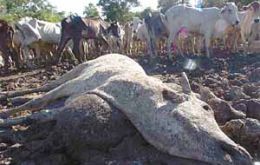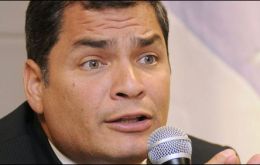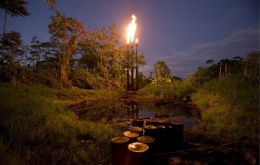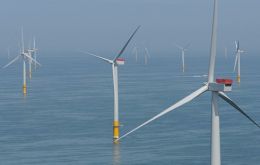MercoPress. South Atlantic News Agency
Environment
-
Thursday, August 29th 2013 - 02:20 UTC
Freezing frosts kill 4.000 cattle in landlocked Paraguay

Freezing cold temperature from heavy frosts are estimated to have killed at least 4.000 head of cattle in landlocked Paraguay, according to the primary reports from the country’s National Animal Quality and Health service, Senasa.
-
Monday, August 26th 2013 - 08:25 UTC
Rising sea temperature will reduce krill growth habitat in Antarctica

Antarctic krill are usually less than 6 cm in length, but their size belies the major role they play in sustaining much of the life in the Southern Ocean. They are the primary food source for many species of whales, seals, penguins and fish.
-
Saturday, August 24th 2013 - 18:28 UTC
Gibraltar criticizes latest incident at artificial reef; Picardo opens window for talks

Gibraltar has strongly criticised Spanish police for sending divers to inspect an artificial reef in waters claimed by the British territory. Governor Sir Adrian Johns said the action constituted a serious violation of UK sovereignty over Gibraltar.
-
Thursday, August 22nd 2013 - 23:43 UTC
China will build and finance two dams in Patagonia equivalent to 10% of Argentine power demand

Argentina's government this week awarded a 4 billion dollars contract for the construction of two hydroelectric dams to a consortium led by China Gezhouba (Group) Co. and which includes Argentine firms Electroingenieria SA and Hidrocuyo SA.
-
Thursday, August 22nd 2013 - 00:35 UTC
Rio do Janeiro mayor questions Brasilia’s 2016 Olympic Games policy

The mayor of Rio de Janeiro has said it is a shame his city will be hosting the Olympic Games in 2016 because Brazil lacks a sports policy. Eduardo Paes said that his city should not pay for high performance athletes.
-
Friday, August 16th 2013 - 17:46 UTC
Ecuador ‘forced’ to drill for oil in pristine Amazon rainforest; ‘rich countries have failed us’

Ecuador has abandoned a conservation plan that would have paid the country not to drill for oil in previously untouched parts of Yasuni National Park in the Amazon rainforest. President Rafael Correa said rich nations had failed to back the initiative, leaving Ecuador with no choice but go ahead with drilling.
-
Wednesday, August 14th 2013 - 20:21 UTC
Shackleton’s Endurance could still be in good conditions on the Antarctic sea bed

Ernest Shackleton's famous ship, the Endurance, which he had to abandon in 1915 on his ill-fated Antarctic expedition, is probably still in very good condition on the ocean floor. This is one conclusion from research that studied how sunken wood degrades in southern polar waters.
-
Wednesday, August 14th 2013 - 03:13 UTC
Chevron-YPF partnership splits the Argentina/Ecuador ‘progressive’ entente

US petroleum giant Chevron has warned that the continuing legal battle with Ecuador's government over pollution charges could put in jeopardy the company's partnership with YPF to exploit the Vaca Muerta shale reserves in the Patagonian province of Neuquén, Argentina.
-
Sunday, August 11th 2013 - 21:51 UTC
Beyond pigs in the pipeline: getting ahead of the leaks

The 2010 Kalamazoo spill and the 2013 Exxon leak in Arkansas are the most glaring incidents, but these are just the big leaks that are found right away and reported. Most leaks are found eventually—but there is money to be saved and damage to be avoided by catching them at the smallest rupture. Right now, we rely on pigs in the pipeline to do this.
-
Saturday, August 10th 2013 - 01:58 UTC
UK opens second largest offshore wind farm in the world

Greater Gabbard wind farm, which is reportedly the second largest offshore wind farm in the world, costing £1.3 billion and generating enough clean electricity to power over half a million homes, was officially opened off the British coast of Suffolk by the Energy and Business Minister Michael Fallon.
